How To Grow Pumpkins
 Perhaps, like me, you decided that you wanted to learn how to grow pumpkins at a young age, when you visited a pumpkin patch for the first time to pick out a jack-o’-lantern for Halloween.
Perhaps, like me, you decided that you wanted to learn how to grow pumpkins at a young age, when you visited a pumpkin patch for the first time to pick out a jack-o’-lantern for Halloween.
Or perhaps you became interested in how to grow pumpkins later, when you were looking to add to your vegetable garden.
Perhaps you visited a country fair and saw a giant pumpkin contest being judged, and that was when you decided to learn how to grow large pumpkins.
Whatever the case, this is the guide for you. In it you will learn how to grow giant pumpkins that can be used for autumn decorations or used for cooking.
In this guide on how to grow pumpkins, I will begin by discussing what a pumpkin is and why it is different from other types of squash. I will discuss some of the common characteristics of pumpkins, as well as the structure and function of different parts of the plant.
Then I will start discussing the important aspects of how to grow pumpkins successfully. You may be wondering: “How do pumpkins grow?” I will talk about how choosing the right growing area, which is very important when you start learning how to grow pumpkins, because they will tend to ramble along vines that can take over your garden otherwise. I will explain getting the soil ready for how to grow pumpkins, along with pH testing and organic applications to the soil, nutrients, cover crops, and how to build up the soil to get it ready for pumpkins.
Next I will talk about how to grow pumpkins by starting seeds early and then planting seedlings, or by directly seeding them into the ground. In this section, I will then cover planting and spacing your seeds. Giving your seedlings enough room to spread out as they grow is another very important aspect of how to grow pumpkins that thrive.
I will discuss the growth stages of pumpkin plants, from seedling growth, to the growth of leaves and root structure, and finally the growth of the fruit itself. This section will be important for understanding how to grow pumpkins in a way that properly maintains them at each stage.
Next I will discuss how to fertilize and water your pumpkin plants. I will cover chemical fertilizers, what strategies to use when fertilizing, and the best ways to water your plants. Then I will cover how to protect your pumpkins from pests and diseases.
Finally, I will talk about pinching and pruning techniques as well as how to know when it is the right time to harvest your pumpkins, followed by a short conclusion.
I hope you enjoy my guide on how to grow pumpkins! I think they are a very fun and rewarding plant to grow, and hopefully soon you will too.
1. What is a Pumpkin?
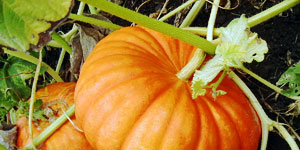 Pumpkins come in all shapes and sizes. They can be used for ornamental or decorative use, as well as eaten as food. They can range in size from small fruits, weighing only a few ounces, to hundreds of pounds. The choice of variety is almost infinite, with many individual varietals receiving a lot of attention because of their uniformity in size, shape, or color.
Pumpkins come in all shapes and sizes. They can be used for ornamental or decorative use, as well as eaten as food. They can range in size from small fruits, weighing only a few ounces, to hundreds of pounds. The choice of variety is almost infinite, with many individual varietals receiving a lot of attention because of their uniformity in size, shape, or color.
As you learn how to grow pumpkins, you will have to choose the varietal you want to begin with based on what you will use it for. If you are learning how to grow pumpkins for jack-o’-lanterns or other decorations, you will want a small to medium sized pumpkin with smooth sides and a round or oblong shape. If you are learning how to grow pumpkins for cooking, you will need to select varietals that have sweet, edible pulp. And if you are learning how to grow pumpkins for size or weight competitions, you will want to select varietals that are known to be giants.
There are some characteristics that are common to all pumpkins, and getting to know them will help you to have a better understanding of what a pumpkin is, which can be very helpful in order to understand how to grow pumpkins. All pumpkins are annual plants, meaning they do not come back year after year, and they are very susceptible to frost. Seed that is germinated and grows through the summer will make more seeds that have to be planted the following year. The growing season for pumpkins begins after the last frost date. This can be different for each grower depending on the region she is in. It takes between four and five months, or 120 and 150 days, to grow a mature pumpkin.
All pumpkin varieties are summer plants, which means that the warmest time of the year is the best one during which to grow them. The beginning of July is generally thought to be the point at which pumpkins will begin their most rapid growth, and will continue to do so until harvested or until temperatures decline to the point that they stop growing.
All pumpkins grow on vines. The pumpkins’ vines have tendrils, which will grope around until they find something to fasten to, in order to help anchor the plant in place. Tendrils are how nature helps vine crops protect themselves. Tendrils help to reduce vine movement and therefore protect the plants from wind or other forces that could disturb the plants.
All pumpkins have separate male and female flowers growing on the same plant. Pollination of pumpkins is usually done by bees and other insects looking for nectar in their flowers. All pumpkins have firm outer walls, and like all winter squash, are not grown to be eaten while they are young. This is important to keep in mind if you are learning how to grow pumpkins for use in pies, breads, or other recipes.
Pumpkins are yellow or orange, although some can even be almost reddish. This is the primary characteristic that distinguishes pumpkins from squash. This is important to consider if you are learning how to grow pumpkins for competitions. Most competitive growers, and therefore judges, will consider green fruit to be squash, and will only accept yellow or orange fruits as pumpkins.
2. Choosing the Right Growing Area
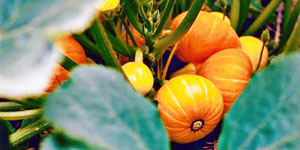 The choice of location is a very important decision in how to grow pumpkins because the plants need a lot of soil and sun, and a large area in which to grow. The number one ingredient for how to grow pumpkins on a particular site is the amount of sunlight it receives. Since many of you are probably backyard gardeners, and the size of American backyards has gotten smaller and smaller over the years, the amount of good space available in yards – the kind of space that will be best for how to grow pumpkins that thrive – has been in decline.
The choice of location is a very important decision in how to grow pumpkins because the plants need a lot of soil and sun, and a large area in which to grow. The number one ingredient for how to grow pumpkins on a particular site is the amount of sunlight it receives. Since many of you are probably backyard gardeners, and the size of American backyards has gotten smaller and smaller over the years, the amount of good space available in yards – the kind of space that will be best for how to grow pumpkins that thrive – has been in decline.
2a. Sun
A good rule of thumb is to select a site that has total exposure no later than eight o’clock in the morning, and which continues until at least six o’clock at night. Anything less than twelve hours of full sun a day will be difficult in terms of how to grow pumpkins that have good color and size. The best locations for full sun will be on the southern side of the garden, with no trees or tall buildings nearby to block out sunlight.
2b. Wind
If you already have a site that receives good sun – and if you are a vegetable gardener you probably do – then the next consideration is how much exposure to wind and frost the site has. Exposure to wind is an especially important aspect of how to grow pumpkins that are healthy and have good foliage. Protecting pumpkin plants form high winds is very important because the plants contain large leaves, and hundreds of them. Wind can tear apart leaves, break vines, or otherwise disturb the plants. Natural screens like hedges and thickets are a great way to significantly lessen the amount of wind your plot receives. You can also grow protective crops on the side of the patch that receives prevailing winds, such as trellised beans, corn, or other tall crops; or, you can raise a protective short fence around them.
2c. Elevation
The elevation of the garden is another important consideration when you are choosing a site for how to grow pumpkins. What I mean is not the sea level of the garden but the relative elevation of the pumpkin patch as compared to the rest of the garden. Low areas of the yard should be avoided if at all possible. These areas will be the coldest ones in your yard, and will therefore have the latest frosts in Spring and the earliest frosts in Fall. Lower areas in your garden will also be the wettest, and can be more prone to flooding in the event of high amounts of rainfall. Pumpkin fruits grow while resting on the ground, and should therefore be kept away from areas where they might become waterlogged and susceptible to rot.
2d. Soil
The final important consideration when you are choosing a space for how to grow pumpkins is the soil texture and quality, although if there are problems they can be addressed. Soil should be well drained and have an abundance of organic material. The soil pH should be slightly acidic, or between 6.5 and 6.8 pH. The texture of the loam should have equal amounts of sand, clay, and humus. This is ideal soil, but you can usually find soil of this quality already present in your garden, or else amend the soil already there in a season or two.
To recap, when choosing a location when you are first learning how to grow pumpkins, look for full sun at least twelve hours a day, high ground, natural protection from the wind and good soil.
3. Getting the Soil Ready For Your Pumpkins
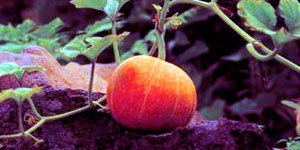 Once you have selected a growing area, the next step in how to grow pumpkins revolves around assessing the soil quality and fixing anything that might be wrong with it. Pumpkins are surprisingly aggressive plants, but good growing soil is more or less the only consideration needed for how to grow pumpkins that are health and flourishing. Large, healthy pumpkins can be grown on marginally rich soil and with only little attention, but this is the exception to the rule and more luck than anything. Still, keep in mind that the more knowledge you gather and apply when learning how to grow a pumpkin, the luckier you may get.
Once you have selected a growing area, the next step in how to grow pumpkins revolves around assessing the soil quality and fixing anything that might be wrong with it. Pumpkins are surprisingly aggressive plants, but good growing soil is more or less the only consideration needed for how to grow pumpkins that are health and flourishing. Large, healthy pumpkins can be grown on marginally rich soil and with only little attention, but this is the exception to the rule and more luck than anything. Still, keep in mind that the more knowledge you gather and apply when learning how to grow a pumpkin, the luckier you may get.
3a. pH Testing
The first step to how to grow pumpkins in rich soil is to have your garden soil tested. The very minimum test you perform or have performed should be for the pH of the soil. This test can be performed by the home gardener with a high degree of accuracy, while other tests should be sent to labs or agencies trained in their application.
A pH test can be done in only fifteen or twenty minutes depending on the texture of the soil and the number of random tests you want to make. pH of soil is an important measurement to understand because it bears heavily on the availability of other major plant nutrients. pH measures the amount of hydrogen present in the soil and as such determines whether soil is acidic or basic. pH is measured on a scale of 1 – 14. Soil is considered neutral when its pH is 7, acidic when it is lower than 7 and basic when it is higher. People sometimes refer to acid soil as “sour” and basic soil as “sweet.”
The pH of most soils will fall into a broad range around neutral (7) with some measurements going as low as 4 and others, as high as 9. The majority of soils in the US will have pH test results in the 4 – 9 range depending on the region where you live. Generally speaking, most gardeners will have pH regions below 7, but some regions of the US never experience acidic soils and can even be plagued with high amounts of calcium and basic soils with pH measurements well above 7.
When you are making a test of soil, especially for how to grow pumpkins, which will range all over their garden plot, you should begin by gathering a random sample of the soil in your garden. It is very unlikely that the soil pH will vary too much from one section of your yard to another, unless you have carried out soil improvements for many years in only one section. Within your garden area, this fact is even truer. It is not likely that pH will vary much within a garden area, but a random sample is made to ensure you have accurate results.
Pumpkins grow best in soil that has a pH range between 6.5 – 6.8, or that is slightly acidic. This is a range which also suits most summertime vegetable crops, so it is not surprising that pumpkins do well in the same soils as tomatoes, squash, corn, or grass have done well. Following good cultural methods for your region of the country as it relates to growing tomatoes will also guarantee success in pumpkins.
The reason pH levels are so important is because all plants have some preference as to what range of pH they prefer. The pH preference range is determined by what elements are most necessary to that plant. Acid loving plants require more of elements like iron, sulfur, and aluminum, while most vegetable crops need more calcium and magnesium.
The procedures for adjusting soil pH are easily carried out with common soil additives. If your soil is too acidic for how to grow pumpkins (pH below 6) add limestone at a rate of fifty pounds per 1000 square feet. If the soil is too basic (pH above 7) add sulfur, aluminum sulfate, or a healthy dose of organic matter. The process of correcting soil pH may take a full growing season because changing the chemical properties of the soil is a slow process. In most cases, correcting pH will be rewarded in the next growing season. Test for pH four to six weeks after the addition of lime or sulfur to see if the pH has changed. You should see some movement towards the target range of 6.5 – 6.8.
3b. Nutrients
The next test you should make when getting the garden ready for how to grow pumpkins is for the major plant nutrients. These are Nitrogen, Phosphorous, and Potassium. Their symbols of N, P, and K should be recognizable to most gardeners because every package of fertilizer on the market has the symbols of these nutrients in the order N-P-K. When we talk about a fertilizer with an analysis of 15-8-12 that means it contains fifteen percent nitrogen, eight percent phosphorous and 12 percent potassium by weight. Each of these major nutrients plays a different role in plant growth and metabolism, and all are important.
Nitrogen is responsible for the development of vines and leaves, as well as the overall green growth of the plant. Nitrogen deficiencies can be detected if there are yellowing leaves, or slow or retarded growth. Nitrogen is very water soluble and so it can leach from sand very quickly. Therefore, nitrogen should be added to soil periodically throughout the growing season.
Phosphorus is responsible for the flower and rood development, and is also important for helping the plant fight off diseases. Phosphorus has a tendency to remain in the soil, and will not leach as quickly as nitrogen does. Because of this, phosphorus should be mixed into the soil, rather than simply spreading it on top. Bone meal and rock phosphate are both good sources of organic phosphorus.
Potassium is responsible for many of the metabolic functions of the pumpkin plant, including the development of carbohydrates into fruit. Therefore healthy amounts of potassium are required to produce large, healthy pumpkins. Much like phosphorus, potassium tends to stay in the soil, and not leach through it like nitrogen; it should therefore be worked into the soil.
Test kits for nutrients are available online and at garden centers, but laboratories will also do comprehensive soil tests for affordable prices. These labs will not only provide a full listing of the pH and nutrient amounts in your soil, but will also often provide recommendations for how to amend the soil to make it suitable for vegetable gardening.
3c. Building the Soil into Hills
In addition to preparing the overall soil of your garden to make it ready for the growing season, a special consideration in how to grow pumpkins is in the preparation of the immediate area of the seedlings once they are planted. Pumpkins are typically planted in small hills. This affords the benefit of growing in raised beds, and also describes the practice of planting more than one seedling in the same area.
The most obvious benefit to raising the soil bed into a small hill is that mounded soil will heat up faster than compacted belowground soil. This aids in seed germination and also in overall pumpkin growth. Hills also create better air circulation and water drainage in the soil. The act of preparing the hill will loosen the soil and allow for more air to enter, and raising beds aids in draining excess moisture away from the planting area.
All in all, building the soil into hills can benefit pumpkin growers because it is one of the few soil preparations that can accomplish increased soil temperature and better drainage at the same time. Obviously, the addition of mulch and row covers can greatly enhance the benefits that planting in hills affords.
Pumpkin hills should be constructed so that soil is elevated by 12-18 inches and gradually slopes downward in an area about eight to ten feet in diameter. This area will be the nursery for your young pumpkin plants at that start of the season.
4. Pumpkins Seeds and Planting
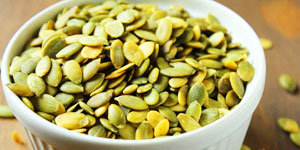 When learning how to grow pumpkins, there are a number of different things that have to be taken into account during the planting phase, including whether to seed directly or indirectly, how to plant seeds and seedlings, and how far apart to space them.
When learning how to grow pumpkins, there are a number of different things that have to be taken into account during the planting phase, including whether to seed directly or indirectly, how to plant seeds and seedlings, and how far apart to space them.
4a. Indirect Seeding
Indirect seeding is the method of germinating seeds in locations other than their final growing area. It usually takes place indoors. You should start by germinating seeds in small containers for transplanting later in the garden. It’s best to use small peat pots filled with a light planting medium. These can be purchased at local garden centers.
Seeds should be planted about one to 1½ inches below the soil surface, with the pointed end of the seed facing down. This helps the seedling to push through the media while it grows. The seed leaves are attached to the outer covering of the seed, o the whole seed will emerge from the soil as the seedling grows, and will fall off the plant as the seed leaves unfurl. The first roots will emerge from the pointed end of the seed.
Newly planted seeds should be planted in a warm area, such as on top of a refrigerator. The best germination temperature is between 75 and 85 degrees Fahrenheit. When this range is obtained, germination will happen in three days or less. This is an exciting time, especially when you are first learning how to grow pumpkins, because it marks the start of the growing season and the start of great pumpkins!
Seedlings should be exposed to as much light as possible after they emerge. Growing inside usually requires additional light sources. Erecting a shop light fixture with fluorescent tubes over your plants is probably the best way to provide additional light. These lights should be placed so that seedlings are no more than six inches away from them. You may have to adjust your fixture or pot placement as growth proceeds. But since the plants will be indoors for only two or three weeks, this is usually not a big hassle.
In addition, moisture levels and air circulation are important considerations during the early stages of growth. Pumpkin plants are very sensitive to disease when they are grown in overly moist media or in low ventilation environments where humidity is high. Never water directly onto the seedlings, and never cover them with plastic, as this will increase humidity in the growing area. These precautions also apply to the area where you will finally transplant your seedlings. If you choose to plant them in a protective enclosure, be sure that there is enough light and good ventilation.
The advantages of starting a seed early are many, but the key ones are the ability to control and monitor the early stages of growth, and the ability to start seeds before the last frost date has passed. This latter consideration will allow you to lengthen the start of the growing season, which in turn will ensure your pumpkins are reaching maturity during the hottest days of the summer.
4b. Direct Seeding
Direct seeding is the germination of the seed in the final growing area. The distinct advantage of direct seeding over indirect seeding is that new seedlings do not have to be transplanted or moved. Transplanting, no matter the precautions taken, can stress the new seedling and slow down the momentum of growth.
Planting and germinating seeds outdoors requires the same steps taken in planting and germinating indoors. The seed is planted the same way, and it can help to prepare the growing area by mixing in some seed starting media. The lighter soil mixture will help in the early stages of germination.
Direct seeding should occur when the soil is warm, several weeks after the last frost date. Recall that the ideal temperature for pumpkin seed germination is 75 – 85 degrees F. In more northern latitudes, it will take an extremely warm day in early May to accomplish this.
Whether you choose to seed indirectly or directly will be based on the time you have available, the last frost date in your area, and the size you want your pumpkins to grow. If you are growing pumpkins for size competitions, I recommend starting them indoors as early as possible. Otherwise, direct seeding is a suitable method. Either method will be successful as long as you cater to the needs of the plants.
4c. Spacing Seedlings
There isn’t much you have to remember about planting either seed or transplants of pumpkins other than the obvious: pumpkins require a lot of space. Plants cannot be overcrowded in small garden plots. The more space allocated to each plant, the better. In a 5′ x 15′ garden plot, you can grow two pumpkin plants. This may seem like far too much space, but once you know how to grow pumpkins, you will realize that they spread like crazy!
You begin by direct seeding or transplanting your seedlings in a thoroughly prepared hill. You should expect losses from both methods and as a result, you should plant several candidates for each hill. If you plant five seeds or seedlings per hill, you should mar the locations of each if they come from different varietals.
You can pant as many as ten seeds per hill to start, and wait until the seedlings have each developed between five and seven leafs before you begin culling them. The reason for planting so many seeds or seedlings to start is because germinating and nurturing pumpkin seeds can be a risky business. You will undoubtedly lose plants to poor germination, unexpected frosts, or insects.
Each hill should have one plant when final culling is complete, and this plant should be spaced at least twenty feet from its nearest neighbor if space permits. These plants should be pampered and spoiled as much as possible, because you want to make sure there is no chance of losing them.
5. Growing and Maintaining Pumpkins
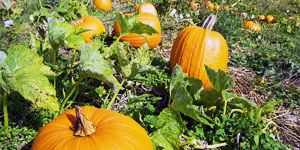 In this section I will cover how to grow pumpkins using organic and inorganic fertilizers, how to water pumpkin plants, and provide some basic disease and pest protection tips. Growing pumpkins successfully can be a tricky business, but once they are established, if you take good care of them, they will reward you at the end of the season.
In this section I will cover how to grow pumpkins using organic and inorganic fertilizers, how to water pumpkin plants, and provide some basic disease and pest protection tips. Growing pumpkins successfully can be a tricky business, but once they are established, if you take good care of them, they will reward you at the end of the season.
5a. Fertilizer
You can choose to use organic or inorganic fertilizer for your pumpkins. Both have advantages and drawbacks. I typically prefer to use organic methods, because they help to build the overall quality of the soil in terms of nutrient availability and structure. Organic methods can have more long-term benefits to your garden as a whole. Organic methods are also generally more inexpensive than inorganic fertilizers, and are often even free. Inorganic fertilizers have the advantage of allowing you to specifically target an area of your garden for a particular ratio of Nitrogen, Phosphorus, and/or Potassium, as well as other chemicals that may assist with rapid growth of your plants. But they have the drawback that you will have to reapply them year after year, and your soil will eventually become poor and dependent on them.
5b. Organic Fertilizer
Regardless of the source of organic fertilizer you choose to implement, manure should be a basic ingredient in your soil building and fertility efforts. Other organic materials such as compost should also be used. In addition, more concentrated forms of organic plant nutrients exist, and many growers use these in addition to manure. Popular organic fertilizers are dried blood meal, cottonseed meal, rock phosphate, bone meal, and greensand. All have importance in any organic fertilizer program and each is preferred by one gardener or another. Organic sources of plant nutrients must be broken down in the soil before the plant’s roots can use them. This process provides a slow feed and also reduces the problems that come with overfeeding. Dried blood and cottonseed meal are both used as concentrated sources of organic nitrogen, while bone meal and rock phosphate provide phosphorous and greensand provides potassium, along with other minerals.
5c. Inorganic Fertilizer
Many gardeners supplement their fertilizer programs with the use of chemical fertilizers. These can be purchased as bagged dry goods that can be applied directly to the soil, or as soluble powers that are mixed with water and sprayed on the plants. Most chemical fertilizers contain all the major plant nutrients but in varying amounts. Balanced products like 10-10-10 or 15-15-15 are best for pumpkin plants, but you will undoubtedly come up with a solution that is optimal for your garden’s needs.
My advice to someone who is just learning how to grow pumpkins is to supplement manure and compost with balanced chemical fertilizers that fortify the soil, and use water soluble fertilizers during the growing season to enhance growth. This is especially true if you are attempting to grow pumpkins for size.
5d. Watering
Moisture is essential to healthy pumpkin growth, and when you consider that 80% of a pumpkin’s weight is water, it’s easy to see why watering is an important ingredient to growing pumpkins. Water is also responsible for the movement of plant food and nutrients through the roots and through the plant’s water and nutrient delivery system. Without water, plant food becomes almost unavailable and metabolic functions and carbohydrate development suffer severely, if not end altogether.
The standard recommendation for pumpkins is that they should receive approximately one inch of rainfall per week, or have the equivalent amount applied manually. Slightly more than this will enhance growth, but very much more can be as bad as no rainfall. This is not necessarily true if you are growing pumpkins in sandy soil: if you do, you will need to apply more moisture. If your soil is rich in clay, you will need to apply less. High soil moisture levels, combined with a canopy of leaves shading the soil can create ideal conditions for the spread of diseases like mildew and blight. A flood of water can also temporarily deprive your plant’s roots of oxygen, which can effectively drown them.
5e. How To Grow Pumpkins Without Insects and Disease
A comprehensive guide to the kinds of pests and diseases that can attack pumpkins would be longer than this entire guide on how to grow pumpkins, but I can give some general tips on how to prevent your plants from coming under attack. Prevention is always the best cure for any diseases or pests that could plague your garden, and the number one preventative measure is to ensure that you are setting up the proper growing conditions for pumpkins: lots of sunlight, aerated hills, and not too much moisture. You can grow without these controls, but you run the risk of losing individual plants or even an entire crop. I also recommend using organic pesticides, especially if you are planning to grow your pumpkins for food, or intend to use the growing area for other vegetables or fruits in the future.
The best organic insecticides to prevent against vine borers, squash bugs, and aphids – the top enemies of pumpkin growers – are BT, Rotenone, and diatomaceous earth. These are fairly effective at controlling at the larval stage of insect development. If any vine is found to have eggs or larvae in it, that section of the vine should be removed and destroyed. I also recommend investing in a good number of ladybugs and several praying mantids to patrol your garden, as they will seed and destroy harmful insects that you may otherwise miss. Check your plants regularly for pests, and apply organic (or inorganic, if you prefer) pesticides wherever you see them.
Disease is best prevented by ensuring that you are not overwatering your pumpkins or allowing the soil to become overly moist. High humidity will also assist the spread of most diseases that strike pumpkins, which is why it is important to plant them in hills that receive good air circulation. You can treat some diseases such as damping-off and stem blight with an application of fungicide, but for the most part, disease is easier to prevent than it is to treat. Infected plants or sections of vine should be immediately removed and destroyed. Do not compost or mulch diseased sections of plant, as this will allow fungi and mildews to overwinter and re-attack the next year.
6. Final Word
 Now you have all the tools you need in order to understand how to grow pumpkins in your own backyard! In this guide we have covered selecting your growing area, getting the soil ready for your pumpkins, seeds and planting, and growing and maintaining pumpkins. All that is left is harvest! You can harvest your pumpkins by simply sawing off the vine where the fruit is attached. Pumpkins should be harvested when they are richly yellow-orange if you are growing them for food or for decorations like jack-o’-lanterns. If you are growing them for competitions, keep them on the vine as long as possible to let them gain as much weight as they can. Whatever you are learning how to grow pumpkins for, have fun!
Now you have all the tools you need in order to understand how to grow pumpkins in your own backyard! In this guide we have covered selecting your growing area, getting the soil ready for your pumpkins, seeds and planting, and growing and maintaining pumpkins. All that is left is harvest! You can harvest your pumpkins by simply sawing off the vine where the fruit is attached. Pumpkins should be harvested when they are richly yellow-orange if you are growing them for food or for decorations like jack-o’-lanterns. If you are growing them for competitions, keep them on the vine as long as possible to let them gain as much weight as they can. Whatever you are learning how to grow pumpkins for, have fun!

